loanDepot Bundle
How Did loanDepot Revolutionize Mortgages?
loanDepot, a titan in the non-bank mortgage lending arena, emerged with a bold vision: to reshape the home financing landscape. Founded in 2010 by Anthony Hsieh, loanDepot bravely entered the market during a period of financial upheaval. This strategic move, coupled with a commitment to innovation, set the stage for its remarkable ascent.
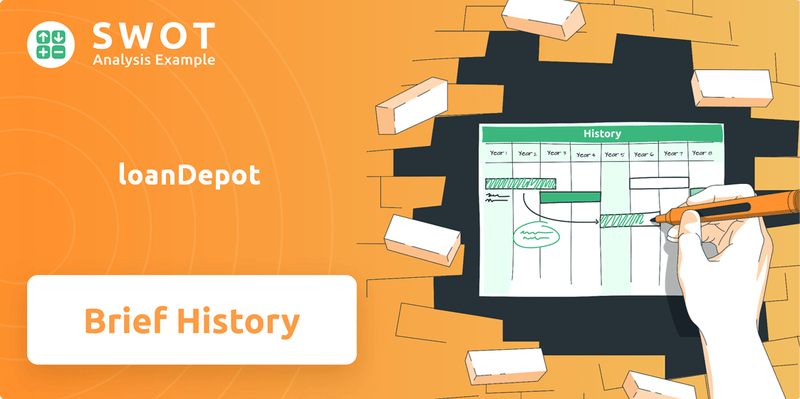
This loanDepot SWOT Analysis reveals the company's journey from its origin in Irvine, California, to becoming a leading mortgage originator and servicer. Exploring the brief history of loanDepot offers insights into its strategic pivots, technological advancements, and the key milestones that shaped its trajectory. From its early years to its current market position, understanding the loanDepot company background is crucial for anyone interested in the mortgage industry's evolution and the impact of loanDepot's founder.
What is the loanDepot Founding Story?
The loanDepot's story began in 2010. The company's origin is rooted in the vision of Anthony Hsieh, a seasoned entrepreneur with a proven track record in the mortgage sector. His prior ventures, LoansDirect.com and HomeLoanCenter.com, laid the groundwork for his next endeavor.
Hsieh launched loanDepot with a clear mission: to revolutionize the mortgage process. He aimed to address the inefficiencies of traditional lending, focusing on technology to streamline operations. The initial focus was on providing a range of mortgage and refinance loans.
From the start, loanDepot was built on a foundation of innovation and customer service. Hsieh assembled a team of 50 individuals who shared his commitment to delivering value. While the exact details of the initial funding aren't specified, Hsieh's prior successes likely played a role in securing the necessary resources to launch the company.
loanDepot's inception was driven by Anthony Hsieh's experience and vision.
- Founded in 2010 by Anthony Hsieh.
- Hsieh previously founded and sold LoansDirect.com and HomeLoanCenter.com.
- Focused on using technology to streamline the mortgage process.
- Initial offerings included mortgage and refinance loans.
loanDepot SWOT Analysis
- Complete SWOT Breakdown
- Fully Customizable
- Editable in Excel & Word
- Professional Formatting
- Investor-Ready Format
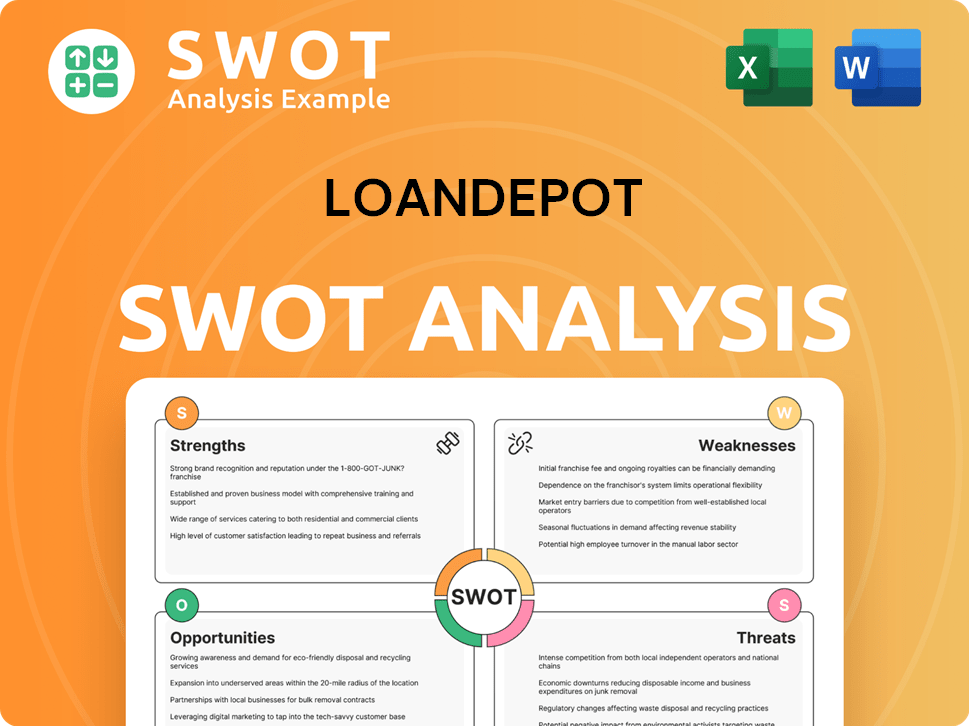
What Drove the Early Growth of loanDepot?
The early growth of the company, now known as loanDepot, was characterized by a strategic expansion of its product offerings and distribution channels. This period saw significant advancements in technology and operational efficiency, setting the stage for future growth. The company's focus on customer experience and technological innovation played a crucial role in its early success, helping it to quickly establish a strong foothold in the mortgage industry. This phase was critical in shaping the company's identity and market position.
By 2012, the company had secured licenses in all 50 states, demonstrating a rapid expansion across the United States. This nationwide reach was a key milestone, enabling it to serve a broad customer base. The ability to operate in every state allowed it to compete effectively on a national scale, significantly boosting its market presence.
In 2013, the company expanded its customer acquisition strategies by entering joint venture and branch-based retail channels. This move broadened its reach beyond the initial direct-to-consumer model. This diversification allowed it to tap into different customer segments and enhance its market penetration, complementing its existing channels.
A significant development was the introduction of proprietary software by 2013, designed to accelerate loan approvals and reduce processing times. This technological innovation set it apart from traditional banks. The focus on technology enhanced efficiency and improved the overall customer experience, a key differentiator in the market.
The company continued to grow its operations and workforce, doubling its full-time employees and initiating national campus expansion in 2011. In 2016, it acquired Closing USA, further streamlining its operations. These efforts were aimed at enhancing efficiency and scale, supported by its technology-driven platforms. For more insights, consider reading about Owners & Shareholders of loanDepot.
loanDepot PESTLE Analysis
- Covers All 6 PESTLE Categories
- No Research Needed – Save Hours of Work
- Built by Experts, Trusted by Consultants
- Instant Download, Ready to Use
- 100% Editable, Fully Customizable
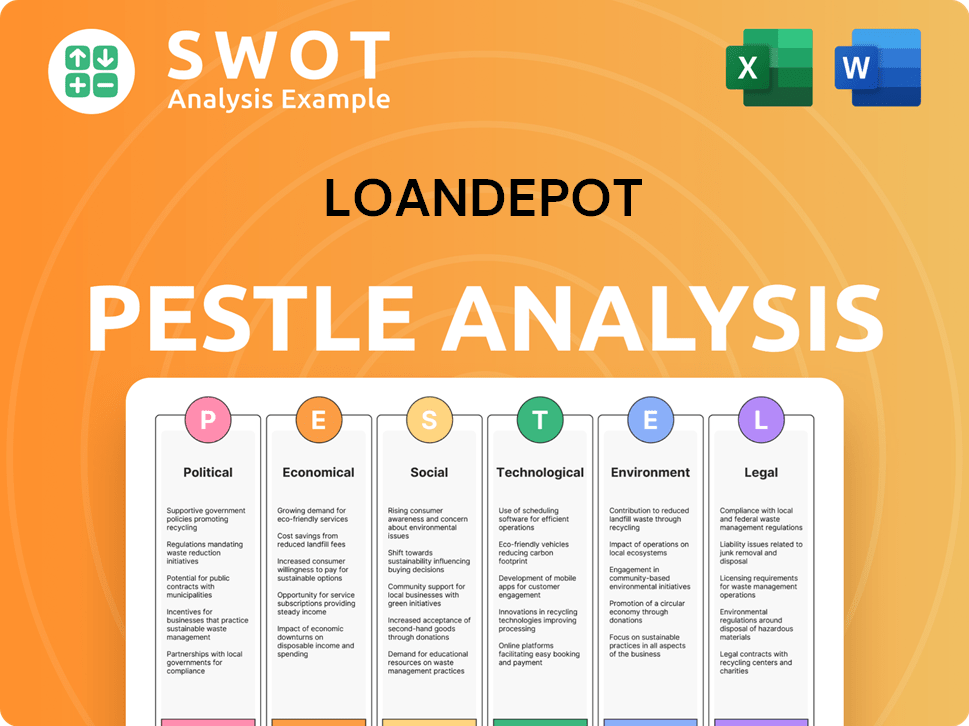
What are the key Milestones in loanDepot history?
The history of the loanDepot company reflects a journey marked by significant milestones, innovations, and challenges within the mortgage industry. From its inception, the company has aimed to streamline the mortgage process through technological advancements and strategic initiatives. Understanding the loanDepot history provides insights into its evolution and impact on the market.
| Year | Milestone |
|---|---|
| March 2017 | Launched 'mello' technology to automate the loan process. |
| January 2018 | Introduced mello Home platform and a home improvement unit. |
| July 2022 | Initiated the 'Vision 2025' strategic plan focused on cost reductions and market adaptation. |
| 2024 | Successfully refinanced its 2025 corporate debt. |
loanDepot has consistently focused on technological advancements to enhance the customer experience. The introduction of 'mello' and 'mello smartloan' has been central to providing a faster and more straightforward mortgage application process. These innovations have positioned the company as a leader in digital mortgage solutions.
The launch of the 'mello' platform in March 2017 was a significant step, enabling customers to apply for mortgages with minimal loan officer interaction. This technology aimed to automate and streamline the loan application process, improving efficiency and customer experience.
'mello smartloan' is an end-to-end fully digital mortgage solution. This innovation provides a fast, straightforward, and hassle-free transaction experience for customers, setting a new standard in the industry.
The mello Home platform, introduced in January 2018, connected pre-approved buyers with realtors. This platform expanded loanDepot's services, providing a more comprehensive real estate solution. This innovation helped to integrate various aspects of the home-buying process.
Despite its achievements, loanDepot has faced several challenges, including market fluctuations and competitive pressures. The company's financial performance has been affected by these challenges, leading to strategic adjustments. The Target Market of loanDepot has also been impacted by these changes.
The company postponed its planned IPO in November 2015 due to unfavorable market conditions. More recently, loanDepot has faced challenges in a housing market characterized by rising interest rates and shifting consumer demand.
In January 2024, loanDepot experienced a cybersecurity incident, resulting in significant costs. The company incurred $25 million in cybersecurity-related costs for the full year 2024 and $14.7 million in Q1 2024, though this decreased to $0.8 million in Q1 2025.
In response to market volatility and to drive profitability, loanDepot initiated its 'Vision 2025' strategic plan in July 2022. This plan focused on cost reductions, business process optimization, and a pivot towards purchase transactions and less rate-sensitive cash-out refinances.
The company reported a net loss of $202 million in 2024, improved from $236 million in the prior year. In Q1 2025, the net loss was $40.7 million, compared to $71.5 million in Q1 2024, indicating progress in managing financial challenges.
loanDepot Business Model Canvas
- Complete 9-Block Business Model Canvas
- Effortlessly Communicate Your Business Strategy
- Investor-Ready BMC Format
- 100% Editable and Customizable
- Clear and Structured Layout
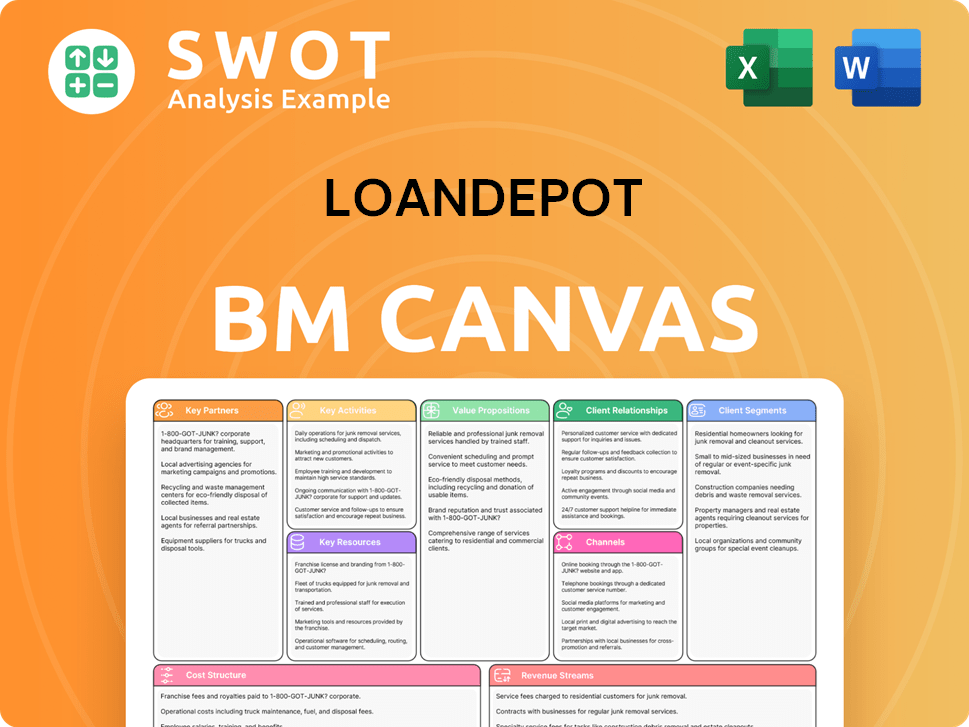
What is the Timeline of Key Events for loanDepot?
The loanDepot story began in 2010 with its founding by Anthony Hsieh. Over the years, the company has navigated market fluctuations, achieved significant milestones, and adapted its strategies. Key developments include nationwide expansion, technological innovations like the mello platform, and an initial public offering (IPO) in 2021. The company has demonstrated resilience and a commitment to innovation, as evidenced by its strategic shifts and financial performance, including achieving profitability in Q3 2024. Throughout its history, loanDepot has aimed to simplify the mortgage process and enhance the customer experience. loanDepot's journey to success reflects its ability to evolve in response to market dynamics and technological advancements.
| Year | Key Event |
|---|---|
| 2010 | Founded by Anthony Hsieh in Irvine, California. |
| 2011 | Expanded nationwide and doubled full-time employees. |
| 2012 | Licensed in all 50 states. |
| 2013 | Expanded into joint venture and branch-based retail channels, and developed proprietary software for faster loan approvals. |
| 2015 | Postponed planned IPO due to market conditions. |
| 2016 | Acquired Closing USA. |
| 2017 | Launched proprietary mello technology for automated loan processing. |
| 2018 | Launched mellohome, a sister company offering mortgage-adjacent products and services. |
| 2021 | Initial public offering (IPO) on the New York Stock Exchange. |
| July 2022 | Announced Vision 2025 strategic plan. |
| August 2024 | Added a first-lien home equity line of credit (HELOC) to its product suite. |
| Q3 2024 | Achieved profitability for the first time in 11 quarters, reporting a GAAP net income of $2.6 million. |
| Q4 2024 | Loan origination volume grew 34% to $7.2 billion, with full-year revenue increasing 9% to $1.06 billion. |
| Q1 2025 | Reported a net loss of $40.7 million, with revenue increasing 23% to $274 million and loan origination volume reaching $5.2 billion, up 14% year-over-year. Founder Anthony Hsieh returned to day-to-day operations and is expected to assume the interim CEO role in June 2025. |
The company is transitioning from its Vision 2025 plan to Project North Star. This new strategy focuses on the homeownership journey, emphasizing first-time homebuyers. It also includes expanding the geographic footprint and partnerships.
For Q2 2025, loanDepot anticipates origination volume between $5.0 billion and $7.5 billion. The projected pull-through weighted rate lock volume is expected to range from $5.5 billion to $8.0 billion. The company foresees a pull-through weighted gain-on-sale margin between 300 and 350 basis points.
The company is investing in AI and machine learning. These investments aim to enhance customer experiences. They are also designed to streamline operations, reflecting a commitment to innovation.
Founder Anthony Hsieh's return and the new strategic plan signal a renewed focus. Leadership is confident in accelerating revenue growth and achieving sustainable profitability in 2025. The company aims to be a 'lender for life.'
loanDepot Porter's Five Forces Analysis
- Covers All 5 Competitive Forces in Detail
- Structured for Consultants, Students, and Founders
- 100% Editable in Microsoft Word & Excel
- Instant Digital Download – Use Immediately
- Compatible with Mac & PC – Fully Unlocked
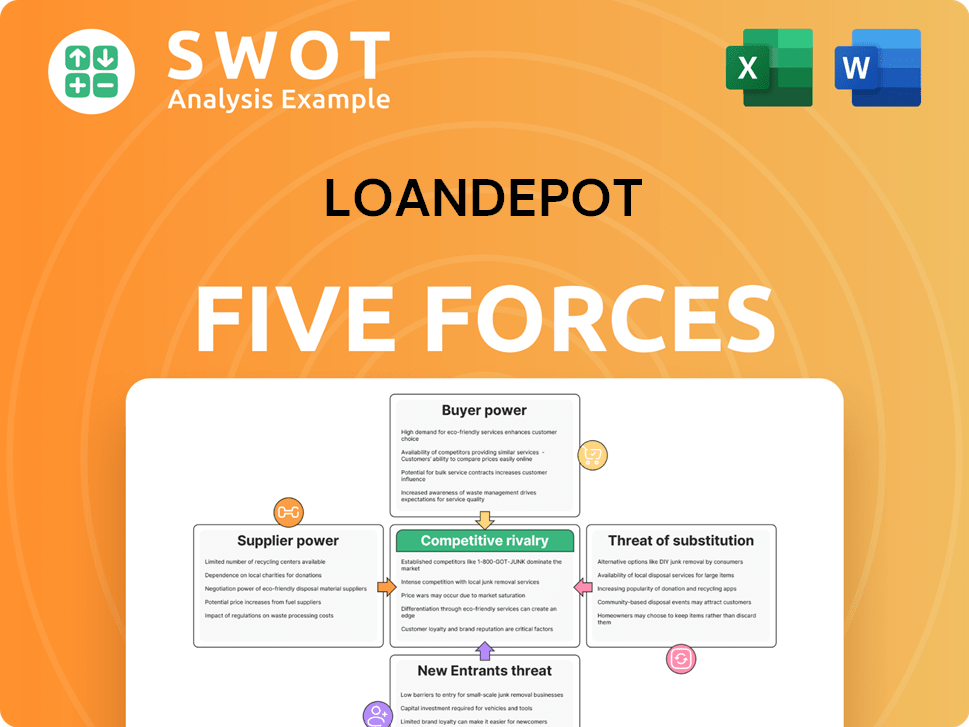
Related Blogs
- What is Competitive Landscape of loanDepot Company?
- What is Growth Strategy and Future Prospects of loanDepot Company?
- How Does loanDepot Company Work?
- What is Sales and Marketing Strategy of loanDepot Company?
- What is Brief History of loanDepot Company?
- Who Owns loanDepot Company?
- What is Customer Demographics and Target Market of loanDepot Company?
Disclaimer
All information, articles, and product details provided on this website are for general informational and educational purposes only. We do not claim any ownership over, nor do we intend to infringe upon, any trademarks, copyrights, logos, brand names, or other intellectual property mentioned or depicted on this site. Such intellectual property remains the property of its respective owners, and any references here are made solely for identification or informational purposes, without implying any affiliation, endorsement, or partnership.
We make no representations or warranties, express or implied, regarding the accuracy, completeness, or suitability of any content or products presented. Nothing on this website should be construed as legal, tax, investment, financial, medical, or other professional advice. In addition, no part of this site—including articles or product references—constitutes a solicitation, recommendation, endorsement, advertisement, or offer to buy or sell any securities, franchises, or other financial instruments, particularly in jurisdictions where such activity would be unlawful.
All content is of a general nature and may not address the specific circumstances of any individual or entity. It is not a substitute for professional advice or services. Any actions you take based on the information provided here are strictly at your own risk. You accept full responsibility for any decisions or outcomes arising from your use of this website and agree to release us from any liability in connection with your use of, or reliance upon, the content or products found herein.